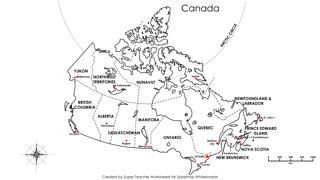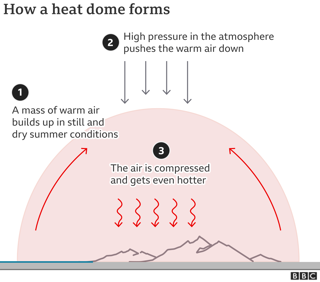What is going on in Canada?
This week (w/c 28 June 2021) has seen record temperatures in Canada, particularly in the western state of British Columbia, where temperatures reached 50°C for the first time ever. Multiple heat warnings were issued last week about the approaching ‘heat dome’ which struck Canada at the end of June. It is being described by meteorologists as a dome because the ridges of high pressure hovering over western Canada have created a pressure cooker effect, stubbornly remaining in one spot, over British Colombia. A heat dome is effectively a lid, trapping pollutants and excessive heat.
Record heat levels were recorded in the Canadian village of Lytton in British Columbia (BC) for 3 consecutive days with 47.9°C on Monday being eclipsed by 49.6°C on Tuesday. These are extraordinary temperatures beating the old record set in 1937 in southern Saskatchewan (45°C), during the Dust Bowl era. Lytton is only 238 kilometres as the crow flies from the state capital, Victoria.

The temperatures for Lytton BC for this week are listed below in Table 1. According to climate-data.org Lytton’s average June temperature is 11°C.
|
Date |
Temperature for Lytton BC |
|
Sunday 27 June |
46.6°C |
|
Monday 28 June |
47.9°C |
|
Tuesday 29 June |
49.6°C |
|
Wednesday 30 June |
37.2°C |
|
Thursday 1 July |
34°C |
|
Friday 2 July |
33°C |
|
Saturday 3 July |
34°C |
Table 1 Temperatures for Lytton, British Colombia
The provincial coroner’s office announced a death toll of 486 ‘sudden and unexplained deaths’ over a 5-day period from Friday (25 June) to Wednesday (30 June). Within this figure 231 people are believed to have died from the heat. The high death toll is because the region's climate is typically mild and therefore many Canadian homes do not have air conditioning.
CBC News forecast the ‘intense’ heat wave on 25 June explaining it was expected due to a persistent high-pressure system remaining above Canada and the US. The explanation for such extreme Canadian weather is that hot, dry desert heat has moved up from over Arizona. This movement, combined with a strengthening El Niño, is causing warmer-than-usual sea surface temperatures over the eastern Pacific, further increasing air temperatures.
Have a look at this BBC article to find out more.

Further reading
-
CBC News Why B.C. may be in for a long, hot summer (from 2015, but relevant to the current situation)
